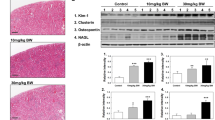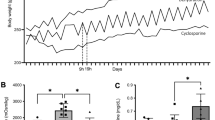Abstract
Renal papillary necrosis (RPN) was induced in Fischer 344 (F344) rats (n=4) using 2-bromoethanamine hydrobromide (BEA) dosed at 150 mg/kg, and in multimammate desert mice (Mastomys natalensis) at 150 and 250 mg/kg (n=4) per group). Control rats andMastomys were dosed with 0.9% saline (n=4 per group). Urine was collected at regular intervals for up to 4 days post-dosing and analysed for low MW metabolites using high resolution1H NMR spectroscopy. The urinary activity of lactate dehydrogenase, γ-glutamyl transpeptidase and alkaline phosphatase was determined using conventional biochemical assays. On termination, histopathological examination of papillae was performed showing the development of extensive lesions in F344 rats at 150 mg/kg BEA.Mastomys appeared much more resistant to BEA and showed normal renal histology at 150 mg/kg and patchy lesions at 250 mg/kg BEA. Enzyme analysis of control urine showed F344 rats to have > 1000% higher γ-glutamyl transpeptidase activity thanMastomys.1H NMR spectroscopic analysis showed that BEA caused a substantial decrease in urinary concentrations of succinate and citrate (0–24 h p.d.) and an increase in creatine (0–96 h p.d.) in both animal models. A decrease in the urinary concentration of 2-oxoglutarate with a subsequent increase by 72–96 h p.d. was also noted in both animal models. Glutaric and adipic aciduria were also induced in both F344 rats andMastomys 0–24 h post-BEA treatment, indicative of an enzyme deficiency in the acyl CoA dehydrogenases. Urinary taurine levels were elevated inMastomys following the administration of BEA, indicating some degree of liver toxicity. Urinary taurine was not elevated in F344 rats following BEA administration, demonstrating further species difference in BEA toxicity.
Similar content being viewed by others
Abbreviations
- ALP:
-
alkaline phosphatase
- BEA:
-
2-bromoethanamine hydrobromide
- F344:
-
Fisher 344
- γGT:
-
γ-glutamyl transpeptidase
- LDH:
-
lactate dehydrogenase
- NMR:
-
nuclear magnetic resonance
- NSAID:
-
non steroidal anti-inflammatory drug
- RPN:
-
2-oxoglutarate renal papillary necrosis
- TMAO:
-
trimethlamine-N-oxide
References
Amiry-Moghaddam M, Nagelhus E, Ottersen OP (1994) Light- and electromicroscopic distribution of taurine, an organic osmolyte, in rat renal tubule cells. Kidney Int 45: 10–22
Anthony ML, Sweatman BC, Beddell CR, Lindon JC, Nicholson JK (1994) Pattern recognition classification of the site of nephrotoxicity based on metabolic data derived from high resolution1H NMR spectra of urine. Mol Pharmacol 46: 199–211.
Bach PH, Bridges JW (1985) Chemically induced renal papillary necrosis and upper urothelial carcinoma. CRC Crit Rev Toxicol 15: 333–409
Bach PH, Hardy TL (1985) Relevance of animal models to analgesic-associated renal papillary necrosis in humans. Kidney Int 28: 605–613
Bales JR, Higham DP, Howe I, Nicholson JK, Sadler PJ (1984) Use of high-resolution proton nuclear magnetic resonance spectroscopy for rapid multi-component analysis of urine. Clin Chem 30: 426–432
Bomhard E, Maruhn D, Vogel O (1986) Comparative investigations on the effects of acute intraperitoneal cadmium, chromium and mercury exposure on the kidney. Uremia Invest 9: 131–136
Burrell JH, Yong JL, Maddonald GJ (1991) Irreversible damage to the medullary interstitium in experimental analgesic nephropathy in F344 rats. J Pathol 164: 329–338
Carlton WW, Engelhardt JA (1989) Experimental renal papillary necrosis in the Syrian Hamster. Food Chem Toxicol 27 [5]: 331–340
Ellis RG, Price BG (1975) Urinary enzyme excretion during renal papillary necrosis induced in rats with ethyleneimine. Chem Biol Interact 11: 473–482
Foxall PJD, Parkinson JA, Sadler IH, Lindon JC, Nicholson JK (1993) Analysis of biological fluids using 600 MHz proton NMR spectroscopy: application of homonuclear two-dimensional J-resolved spectroscopy to urine and blood plasma for spectral simplification and assignment. J Pharm Biomed Anal 11 [1]: 21–31
Gartland KPR, Bonner FW, Nicholson JK (1988) Investigations into the biochemical effects of region-specific nephrotoxins. Mol Pharmacol 35: 242–250
Gregg NJ, Bach PH (1990) 2-bromoethanamine nephrotoxicity in the nude mouse: an atypical targeting for the renal cortex. Int J Exp Pathol 71: 659–670
Harper GS, Axelsen RA (1982) Salicylate-induced renal papillary necrosis in the Gunn rat: the role of bilirubin. Lab Invest 47 [3]: 258–264
Holmes E, Bonner FW, Sweatman BC, Lindon JC, Beddell CR, Rahr E, Nicholson JK (1992) Nuclear magnetic resonance spectroscopy and pattern recognition analysis of the biochemical processes associated with the progression and recovery of nephrotoxic lesions in the rat induced by mercury II chloride and 2-bromoethanamine. Mol Pharmacol 42: 922–930
Holmes E (1992) Proton NMR investigations into the chemical pathology of experimental renal damage. PhD thesis. University of London, Chapter 7, pp 149–206
Holmes E, Caddick S, Lindon JC, Wilson ID, Kryvawych S, Nicholson JK (1995)1H and2H NMR spectroscopic studies on the metabolism and biochemical effects of 2-bromoethanamine in the rat: induction of transient glutaric aciduria. Biochem Pharmacol 49: 1349–1359
Law RO, Turner DPJ (1987) Are ninhydrin-positive substances volume-regulatory osmolytes in rat renal papillary cells?. J Physiol 386: 45–61
Lenz SD, Carlton WW (1991) Decreased incidence of diphenylamine-induced renal papillary necrosis in Syrian hamsters given dimethyl-sulphoxide. Food Chem Toxicol 29: 409–418
Maruhn D, Fuchs I, Mues G, Bock KD (1976) Normal limits of urinary excretion of eleven enzymes. Clin Chem 22: 1567–1577
McComb RB, Bowers GN (1972) Study of optimal buffer conditions for measuring alkaline phosphatase activity in human serum. Clin Chem 18: 97–103
Nakanishi T, Uyama O, Sugita M (1991) Osmotically regulated taurine content in rat renal inner medulla. Am J Physiol 261: F957-F962
Nanra RS (1983) Renal effects of antipyretic analgesics. Am J Med 76: 70–80
Nicholson JK, Wilson ID (1989) High resolution proton magnetic resonance spectroscopy of biological fluids. Prog NMR Spect 21: 449–501
Nuyts GD, Roels HA, Verpooten GF, Bernard AM, Lauwerys RR, DeBroe ME (1992) Intestinal-type alkaline phosphatase in urine as an indicator of mercury induced effects on the S3 segment of the proximal tubule. Nephrol Dial Transplant 7: 225–229
Owen RA, Heywood R (1986) Strain-related susceptibility to nephrotoxicity induced by aspirin and phenylbutazone in rats. Toxicol Pathol 14 [2]: 242–246
Raab WP (1972) Diagnostic value of urinary enzyme determinations. Clin Chem 18: 5–25
Sabatini S (1988) Analgesic-induced papillary necrosis. Semin Nephrol 8: 41–54
Sabatini S, Mehta PK, Hayes S (1981) Drug-induced papillary necrosis: electrolyte excretion and nephron heterogeneity. Am J Physiol 241: F14-F22
Sabatini S, Koppera S, Manaligod J, Arruda JAL, Kurtzman NA (1983) Role of urinary concentrating ability in the generation of toxic papillary necrosis. Kidney Int 23: 705–710
Schmidt-Nielsen B, O’Dell R (1961) Structure and concentrating mechanism in the mammalian kidney. Am J Physiol 200: 1119–1124
Shelley JH (1978) Pharmacological mechanisms of analgesic nephropathy. Kidney Int 13: 15–26
Szasz G (1969) A kinetic photometric method of serum gammaglutamyl transpeptidase. Clin Chem 15: 124–126
Timbrell JA, Draper R, Waterfield CJ (1994) Biomarkers in toxicology. Toxicol Ecotoxicol News 1 [1]: 4–14
Uchida S, Nakanishi T, Kwon HM, Preston AS, Handler JS (1991) Taurine behaves as an osmolyte in Madin-Darby canine kidney cells: protection by polarized regulated transport of taurine. J Clin Invest 88: 656–662
Vanholder R, Lameire N, Eeckhaut W, Ringoir S (1981) Renal function studies in an experimental model of papillary necrosis in the rat. Arch Int Physiol Biochim 89: 63–73
Van Pelt FG, Blankwater MJ (1972) Immunological and clinical-chemical investigations on blood, urine and kidney in ageingPraomys (Mastomys) natalensis with spontaneous glomerulonephritis. Gerontologia 18: 200–216
Waterfield CJ, Turton JA, Scales DC, Timbrell JA (1993) Investigations into the effects of various hepatotoxic compounds on urinary and liver taurine levels in rats. Arch Toxicol 67: 244–254
Author information
Authors and Affiliations
Rights and permissions
About this article
Cite this article
Holmes, E., Bonner, F.W. & Nicholson, J.K. Comparative studies on the nephrotoxicity of 2-bromoethanamine hydrobromide in the Fischer 344 rat and the multimammate desert mouse (Mastomys natalensis). Arch Toxicol 70, 89–95 (1995). https://doi.org/10.1007/BF02733668
Received:
Accepted:
Issue Date:
DOI: https://doi.org/10.1007/BF02733668




